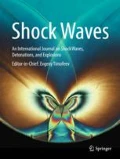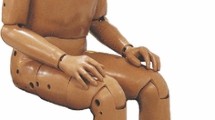Abstract
Understanding the physical mechanisms by which blast waves interact with their surroundings is paramount to protecting the safety of armed service personnel and equipment. This study evaluates and discusses modern technology used in blast pressure measurement as it relates to primary blast injuries such as traumatic brain injury. Factors influencing primary blast injury were established as peak overpressure, impulse, number, and frequency of shock impacts based on a literature review. A simulated confined-corridor breaching environment was used to establish the potential for variability in these key parameters depending on location in a confined blast environment. Wearable blast pressure monitors were compared experimentally to not only laboratory grade pressure transducers but also simulated and empirically modeled blast pressure and impulse predictions at scaled distances between 3.1 and \(13.6\,\hbox {m/kg}^{1/3}\) from 100-g and 200-g suspended Composition C-4 detonations partially confined by the ground. surface ground reflection. Each measurement and predictive technique is detailed and comparatively summarized. Average deviation from the mean in collected pressure and impulse data ranged between 10 and 15%. The disparity in the measured data was lowest in the static pressure range where mild traumatic brain injury is reported to occur.
Similar content being viewed by others
References
Yamamoto, S., DeWitt, D.S., Prough, D.S.: Impact and blast traumatic brain injury: implications for therapy. Molecules 23(2), 245–256 (2018). https://doi.org/10.3390/molecules23020245
Bell, R.S., Vo, A.H., Neal, C.J., Tigno, J., Roberts, R., Mossop, C., Dunne, J.R., Armonda, R.A.: Military traumatic brain and spinal column injury: a 5 year study of the impact of blast and other military grade weaponry on the central nervous system. J. Trauma 66(11), 104–111 (2009). https://doi.org/10.1097/TA.0b013e31819d88c8
USMC: Blast Overpressure Effects. Marine Corps Directorate of Analytics and Performance Optimization. Washington, DC (2019)
Rutter, B.: Pressure Versus Impulse Graph for Blast Induced Traumatic Brain Injury and Correlation to Observable Blast Injuries. Missouri University of Science and Technology, Rolla (2019)
Sajja, V.S.S.S., LaValle, C., Salib, J., Misistia, A.C., Ghebremedhin, M.Y., Ramos, A.N., Egnoto, M.J., Long, J.B., Kamimori, G.H.: The role of very low level blast overpressure in symptomatology. Front. Neurol. 10, 891 (2019). https://doi.org/10.3389/fneur.2019.00891
Robinson, N. (director): Carl Gustav Recoilless Rifle (film). FOB Altimur, 1st Armored Division, 3rd Infantry Brigade, Fort Bliss, TX (2011)
Saljo, A., Svensson, B., Mayorga, M., Hamberger, A., Bolouri, H.: Neuropathology and pressure in the pig brain resulting from low-impulse noise exposure. J. Neurotrauma 25(12), 1397–1406 (2008). https://doi.org/10.1089/neu.2008.0602
Snow, H.: The Carl Gustaf is getting a ‘game changing’ laser-guided munition. Army Times, 9 October 2018 (2018). https://www.armytimes.com/news/your-army/2018/10/09/the-carl-gustaf-is-getting-a-game-changing-laser-guided-munition/
Leibovici, D., Gofrit, O.N., Stein, M., Shapira, S.C., Noga, Y., Heruti, R.J., Shemer, J.: Blast injuries: bus versus open-air bombings—a comparative study of injuries in survivors of open-air versus confined-space explosions. J. Trauma Injury Infect. Crit. Care 41(6), 1030–1035 (1996). https://doi.org/10.1097/00005373-199612000-00015
Borkholder, D.A.: Concept to commercialization of a MEMS-based blast dosimetry system. 18th International Conference on Solid-State Sensors, Actuators, and Microsystems (TRANSDUCERS), Anchorage, AK, IEEE (2015). https://doi.org/10.1109/TRANSDUCERS.2015.7180916
Wiri, S., Needham, C.: Reconstruction of improvised explosive device blast to loading personnel in the open. Shock Waves 26, 279–286 (2016). https://doi.org/10.1007/s00193-016-0644-1
Sochet, I., Gault, K., Hakenholz, L.: Propagation of shock waves in two rooms communicating through an opening. In: Rao, S. (ed.) Direct Numerical Simulations—An Introduction and Applications. IntechOpen (2019). https://doi.org/10.5772/intechopen.87190
Misistia, A., Skotak, M., Cardenas, A., Alay, E., Chandra, N., Kamimori, G.: Sensor orientation and other factors which increase the blast overpressure reporting errors. PLoS ONE 15(10), e0240262 (2020). https://doi.org/10.1371/journal.pone.0240262
Cooper, P.: Explosives Engineering. Wiley-VCH, Albuquerque (1996)
Cernak, I., Kobeissy, F.H.: Blast injuries and blast-induced neurotrauma: overview of pathophysiology and experimental knowledge models and findings. In: Kobeissy, F.H. (ed.) Brain Neurotrauma: Molecular, Neuropsychological, and Rehabilitation Aspects. CRC Press, Boca Raton (2015). https://doi.org/10.1201/b18126-53
Friedlander, F.: The diffraction of sound pulses; diffraction by a semi-infinite plane. Proc. R. Soc. Lond. Ser. A Math. Phys. Sci. 186(1006), 322–344 (1945). https://doi.org/10.1098/rspa.1946.0046
Dewey, J.M.: The Friedlander equations. In: Sochet, I. (ed.) Blast Effects: Physical Properties of Shock Waves, pp. 37–55. Springer, Cham (2017). https://doi.org/10.1007/978-3-319-70831-7_3
Livingston, S., Picon, L., Kim, M.: Mechanisms of TBI. Air Force Center of Excellence for Medical Multimedia, USAFA, CO (2020)
Jorolemon, M.R., Lopez, R.A., Krywko, D.M.: Explosions and Blast Injuries: A Primer for Clinicians. National Center for Biotechnology Information, Bethesda (2020)
DDESB, DoD Ammunition and Explosives Safety Standards, DOD 6055.9-STD. United States Department of Defense, Alexandria, VA (1999)
U. S. Army: Chapter 8, Obstacles, Mines, and Demolitions in FM 3-06-11. Combined Arms Operations in Urban Terrain. Headquarters Department of the Army, Washington, DC (2002)
U. S. Army: Chapter 7, Explosive Urban Entry in FM 3-34-214. Explosives and Demolitions. Department of the Army, Washington, DC (2008)
Peters, P.: Primary blast injury: an intact tympanic membrane does not indicate the lack of a pulmonary blast injury. Mil. Med. 176, 110–114 (2011). https://doi.org/10.7205/MILMED-D-10-00300
Vikas, M., Skotak, M., Schuetz, H., Heller, A., Haorah, A., Chandra, N.: Primary blast causes mild, moderate, severe and lethal TBI with increasing blast overpressures: experimental rat injury model. Sci. Rep. 6, 26992 (2016). https://doi.org/10.1038/srep26992
Bryden, D.W., Tilghman, J.I., Hinds, S.R.: Blast-related traumatic brain injury: current concepts and research considerations. J. Exp. Neurosci. 13, 1–11 (2019). https://doi.org/10.1177/1179069519872213
Song, H., Konan, L.M., Cui, J., Johnson, C.E., Hubler, G.K., Depalma, R.G., Gu, Z.: Nanometer ultrastructural brain damage following low intensity primary blast wave exposure. Neural Regener. Res. 13(9), 1516–1519 (2018). https://doi.org/10.4103/1673-5374.237110
Chen, H.-J., Xu, C., Li, Y., Chen, Z.-Q., Li, G.-H., Duan, Z.-X., Li, X.-X., Zhang, J.-Y., Wang, Z., Feng, H., Li, B.-C.: An open air research study of blast-induced traumatic brain injury to goats. Chin. J. Traumatol. 18(5), 267–274 (2015). https://doi.org/10.1016/j.cjtee.2015.11.006
Kingery, C.N., Bulmash, G.: Airblast parameters from TNT spherical air burst and hemispherical surface burst. Technical Report ARBRL-TR-02555, U.S. Army Armament Research and Development Center, Ballistic Research Laboratory, Aberdeen Proving Ground, MD (1984)
Knowles, B.M., Dennison, C.R.: Predicting cumulative and maximum brain strain measures from hybrid III head kinematics: a combined laboratory study and post-hoc regression analysis. Ann. Biomed. Eng. 45(9), 2146–2158 (2017). https://doi.org/10.1007/s10439-017-1848-y
Hicks, R.R., Fertig, S.J., Desrocher, R.E., Koroshetz, W.J., Pancrazio, J.J.: Neurological effects of blast injury. J. Trauma 68(5), 1257–1263 (2010). https://doi.org/10.1097/TA.0b013e3181d8956d
Hesseini-Farid, M., Amiri-Tehrani-Zadeh, M., Ramzanpour, M., Ziejewski, M., Karami, G.: The strain rates in the brain, brainstem, dura, and skull under dynamic loadings. Math. Comput. Appl. 25, 21 (2020). https://doi.org/10.3390/mca25020021
Swisdak, M.: Explosion effects and properties. Part I - Explosion effects in air. NSWC/WOL/TR 75-116, National Surface Weapons Center, Silver Spring, MD (1975). https://apps.dtic.mil/dtic/tr/fulltext/u2/a018544.pdf
Karlos, V., Karlos, G.: Calculation of blast loads for application to structural components. JRC Technical Reports, European Commission, Luxembourg (2013). https://doi.org/10.2788/61866
UFC 3-340-02: Structures to resist the effects of accidental explosions. Unified Facilities Criteria, Washington, DC (2014)
Needham, C.E.: Blast wave reflections. In: Needham, C.E. (ed.) Blast Waves, pp. 197–225. Springer, Cham (2018). https://doi.org/10.1007/978-3-319-65382-2_13
Committee on Gulf War and Health: Pathophysiology of Blast Injury and Overview of Experimental Data. Gulf War and Health: Long-Term Effects of Blast Exposures, vol. 9. National Academies Press, Washington, DC (2014)
Needham, C.E.: Height of burst effects. In: Needham, C.E. (ed.) Blast Waves, pp. 227–281. Springer, Cham (2018). https://doi.org/10.1007/978-3-319-65382-2_14
Mayorga, M.A.: The pathology of primary blast overpressure injury. Toxicology 121(1), 17–28 (1997). https://doi.org/10.1016/s0300-483x(97)03652-4
Oswald, C.: An Improved Method to Calculate the Gas Pressure History from Partially Confined Detonations. Protection Engineering Consultants, San Antonio (2018)
Johnson, C., Mulligan, P., Williams, K., Langenderfer, M., Heniff, J.: Effect of explosive charge geometry on shock wave propagation. AIP Conference Proceedings 1979, 150021 (2018). https://doi.org/10.1063/1.5044977
Dobratz, B.M.: Explosives Handbook, Properties of Chemical Explosives and Explosive Simulants. URCL-52997, Lawrence Livermore National Laboratory, Livermore, CA (1981)
Hopkinson, B.: British Ordnance Board Minutes 13565 (1915)
Cranz, C.: Leurbuch der Ballistik. Springer, Berlin (1926)
Walter, P.L.: Airblast and the Science of Dynamic Pressure Measurements PCB Piezotronics. Depew, NY (2019)
Kamimori, G.H., Reilly, L.A., LaValle, C.R., Olaghere Da Silva, U.B.: Occupational overpressure exposure of breachers and military personnel. Shock Waves 27, 837–847 (2017). https://doi.org/10.1007/s00193-017-0738-4
Ostertag, M.H., Kenyon, M., Borkholder, D.A., Lee, G., da Silva, U., Kamimori, G.: The Blast Gauge\(^{{\rm TM}}\) system as a research tool to quantify blast overpressure in complex environments. ASME 2013 International Mechanical Engineering Congress & Exposition, San Diego, CA (2014). https://doi.org/10.1115/IMECE2013-65138
Black Box Biometrics: The Blast Gauge System. https://blastgauge.com/
PCB Piezotronics: PCB Model:137B23B Specifications. Depew, NY (2015)
PCB Piezotronics: PCB Model:102B15 Specifications. Depew, NY (2010)
Sherkar, P., Whittaker, A.S, Aref, A.J.: Modeling the effects of detonations of high explosives to inform blast-resistant design. Technical Report MCEER-10-0009, University at Buffalo, State University of New York, Buffalo, NY (2010). https://doi.org/10.13140/RG.2.1.3978.4565
Shin, J., Whittaker, A.S., Aref, A.J., Cormie, D.: Air-blast effects on civil structures. Technical Report MCEER-14-0006, University at Buffalo, State University of New York, Buffalo, NY (2014). https://doi.org/10.13140/RG.2.1.3454.1686
Sochet, I. (ed.): Blast Effects. Physical Properties of Shock Waves. Springer Nature, Cham (2018). https://doi.org/10.1007/978-3-319-70831-7
Needham, C.E.: The Rankine-Hugoniot relations. In: Needham, C.E. (ed.) Blast Waves, pp. 9–17. Springer, Cham (2018). https://doi.org/10.1007/978-3-319-65382-2_3
Reed, G.F., Lynn, F., Meade, B.D.: Use of coefficient of variation in assessing variability of quantitative assays. Clin. Diagn. Lab. Immunol. 9(6), 1235–1239 (2002). https://doi.org/10.1128/cdli.9.6.1235-1239.2002
Skotak, M., Alay, E., Chandra, N.: On the accurate determination of shock wave time-pressure profile in the experimental models of blast-induced neurotrauma. Front. Neurol. 9, 52 (2018). https://doi.org/10.3389/fneur.2018.00052
Walter, P.L.: Physiology and Measurement of Explosions in Air and Underwater. PCB Piezotronics, Las Vegas (2012)
Nyquist, H.: Certain topics in telegraph transmission theory. Proc. IEEE 47(2), 617–644 (1928). https://doi.org/10.1109/T-AIEE.1928.5055024
Shannon, C.E.: Communication in the presence of noise. Proc. Inst. Radio Eng. 37(1), 10–21 (1949). https://doi.org/10.1109/JRPROC.1949.232969
Acknowledgements
The authors would like to thank the Missouri S & T Rock Mechanics and Explosives Research center for their assistance in design and construction of the test mounts used in the experiments, and the Experimental Mine for providing facilities to conduct the experimental tests. The authors would also like to thank the students of the Missouri S & T Energetics Research Group for their contributions to the research and manuscript.
Author information
Authors and Affiliations
Corresponding author
Ethics declarations
Conflict of interest
The authors declare that they have no conflict of interest. The authors did not receive support from any organization for the submitted work. There is no affiliation either direct or indirect between the authors and the sensor manufacturers PCB Piezotronics or Black Box Biometrics.
Additional information
Communicated by C. Needham.
Publisher's Note
Springer Nature remains neutral with regard to jurisdictional claims in published maps and institutional affiliations.
Appendix: Blast parameter plots and selected waveforms
Appendix: Blast parameter plots and selected waveforms
Figure 10 shows graphical representations of the blast parameter data collected from this study for visualization of the data dispersion. A relative mass equivalency factor to trinitrotoluene of 1.35 was used to calculate Kingery–Bulmash parameters for C4. C4 product expansion was simulated using a Jones–Wilkins–Lee equation of state [41]. Impulse was calculated for all measurement distances by discrete integration of measured pressure data over the duration of the initial positive pressure pulse produced by the blast, including the ground-reflected shock wave. Gross positive impulse calculated automatically by the Blast Gauge over the entire 20-ms record duration is shown for comparison to manually calculated positive phase impulse. Figures 11 and 12 show selected overpressure and impulse waveforms for the static and reflected orientations, respectively, produced from the raw unprocessed outputs of each measurement system over the initial positive pressure phase.
Convergence testing of the simulations was conducted for the 200-g C4 charge at the 2-m measurement distance where the magnitude and rate of applied pressure is the most rapid. Convergence testing was conducted at double and half the Euler grid resolutions of \(10\,\hbox {mm} \times 10\,\hbox {mm}\). Static overpressure showed convergence between 64.4 and 72 kPa, and static impulse converged between 39.2 and \(40.6\,\hbox {kPa}\cdot \hbox {ms}\). Convergence test results and plots are shown in Fig. 13.
Rights and permissions
About this article
Cite this article
Langenderfer, M., Williams, K., Douglas, A. et al. An evaluation of measured and predicted air blast parameters from partially confined blast waves. Shock Waves 31, 175–192 (2021). https://doi.org/10.1007/s00193-021-00993-0
Received:
Revised:
Accepted:
Published:
Issue Date:
DOI: https://doi.org/10.1007/s00193-021-00993-0

















